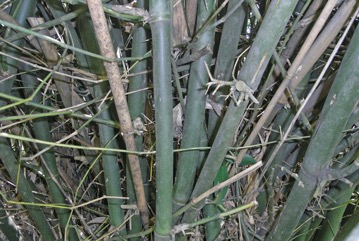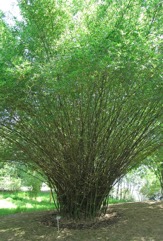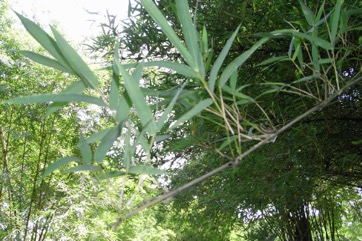Spiny bamboo, Thorny bamboo

A tropical plant. Throughout the Philippines at low and medium altitudes. It grows up to 300 m altitude. It is normally always planted. It can tolerate flooding. It does best with a pH of 5-6.5. It cannot tolerate salty soils. In XTBG Yunnan.
Also known as:
Bambu duri, Bambu gesing, Buloh duri, Buloh sikai, Gesing bamboo, Haur chuchuk, Haur cucuk, Kauayan-tinik, Kida, Mai phai ban, Phai-sisuk, Phaix banz, Piao lahe, Pio titoca, Pring gesing, Pring ori, Rusay roleak, Ru'ssei roliek, Tituka, Tre gai, Tre la nga
Synonyms
- Bambusa pungens Blanco
- Bambusa spinosa Roxb.
- Bambusa spinosa Blume ex Nees [Illegitimate]
- Bambusa stenostachya Hack.
- Bambusa teba Miq.
- Ischurochloa stenostachya (Hack.) Nakai
- Schizostachyum durie Rupr.
- Bambusa arundo Blanco
- ?
Edible Portion
- Shoots, Vegetable
Where does Spiny bamboo grow?
Found in: Asia, Australia, Cambodia, China, Guam, India, Indochina, Indonesia, Kiribati, Laos, Malaysia, Marshall Islands, Micronesia, Myanmar, Pacific, Palau, Philippines, SE Asia, Singapore, Taiwan, Thailand, Vietnam, Yap
Notes: There are about 120 Bambusa species. They are tropical and subtropical in Asia. It is used to make chopsticks in the Philippines. Chemical composition; Young shoots per 100 g edible portion: Water 89 g, protein 4 g, fat 0.5 g, carbohydrates 4 g, fibre 1 g, ash 1 g, Ca 37 mg, P 40 mg, Fe 1.5 mg Vitamin B1 0.1 mg, Vitamin C 10 mg. The energy value is about 120 kJ/100 g.
Growing Spiny bamboo, Thorny bamboo
Cultivation: It can be grown from cuttings of the culm or stem. These send up thin stems and culms develop after 3 years. The number of culms produced increases each year until maturity. Cuttings of the culm about 50 cm long are used. They are planted horizontally at 10 cm depth. Rooting is helped by using rooting hormone. Plants are spaced at 8-10 m apart.
Edible Uses: The young shoots are cooked and eaten. They are usually shredded. They are used in soup.
Production: A clump with 10-40 culms can produce 30 shoots per year. Shoots emerge after the rainy season and can be harvested after 7-15 days. About 6-7 edible shoots can be harvested per clump per year.
Nutrition Info
per 100g edible portion| Edible Part | Energy (kcal) | Protein (g) | Iron (mg) | Vitamin A (ug) | Vitamin c (mg) | Zinc (mg) | % Water |
|---|---|---|---|---|---|---|---|
| Shoots | - | - | - | - | - | - |
Spiny bamboo, Thorny bamboo Photos



References
Ambasta S.P. (Ed.), 2000, The Useful Plants of India. CSIR India. p 66
Arora, R. K., 2014, Diversity in Underutilized Plant Species - An Asia-Pacific Perspective. Bioversity International. p 36
Bircher, A. G. & Bircher, W. H., 2000, Encyclopedia of Fruit Trees and Edible Flowering Plants in Egypt and the Subtropics. AUC Press. p 53 (Also as Bambusa spinosa)
Burkill, I.H., 1966, A Dictionary of the Economic Products of the Malay Peninsula. Ministry of Agriculture and Cooperatives, Kuala Lumpur, Malaysia. Vol 1 (A-H) p 301
Cengel, D. J. & Dany, C., (Eds), 2016, Integrating Forest Biodiversity Resource Management and Sustainable Community Livelihood Development in the Preah Vihear Protected Forest. International Tropical Timber Organization p 125
Dransfield, S. & Widjaja, EA., 1995, Plant Resources of South East Asia. PROSEA No. 7 Bamboos. Leiden. p 60
Hibbert, M., 2002, The Aussie Plant Finder 2002, Florilegium. p 37
Luczaj, L., et al, 2021, Wild food plants and fungi sold in the markets of Luang Prabang, Lao PDR. Journal of Ethnobiology and Ethnomedicine (2021) 17:6
Monsalud, M.R., Tongacan, A.L., Lopez, F.R., & Lagrimas, M.Q., 1966, Edible Wild Plants in Philippine Forests. Philippine Journal of Science. p 477
Ochse, J.J. et al, 1931, Vegetables of the Dutch East Indies. Asher reprint. p 301 (As Bambusa spinosa)
Phon, P., 2000, Plants used in Cambodia. © Pauline Dy Phon, Phnom Penh, Cambodia. p 86
Sang, D. T., & Mizoue, K. O. N., 2012, Use of Edible Forest Plants among Indigenous Ethnic Minorities in Cat Tien Biosphere Reserve, Vietnam. Asian Journal of Biodiversity Vol. 3 (1), p 23-49
Sukarya, D. G., (Ed.) 2013, 3,500 Plant Species of the Botanic Gardens of Indonesia. LIPI p 836
Syst. veg. 7(2):1343. 1830